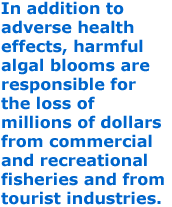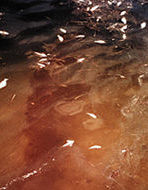

 |
|||
|
On April 2, 2002, Texas Parks and Wildlife Department staff found millions of small dead and dying menhaden fish along a 15-mile stretch of beach on North Padre Island. During February 2002, approximately 1,000 tons of rock lobsters beached themselves at Elands Bay in South Africa. And in 1996, almost 150 Florida manatee — over five percent of the estimated population — died over a two-month period, beset by a pneumonia-like respiratory syndrome. What caused these deadly events?
|
July 9, 2002

  Red tides can kill large numbers of fish. (Images courtesy of Mote Marine Laboratory)
Karenia brevis, previously known as Gymnodium breve, phytoplankton are responsible for Florida red tides. Each cell has a diameter of approximately 32 microns. (Image courtesy of NOAA's Harmful Algal Bloom Forecast Project)
See What are Phytoplankton? for more information.
For more information, see: |
||
|
In each case, the cause was a microscopic aquatic plant known as phytoplankton, or algae. But not just one, or even a few, renegade algae could have been responsible for this level of destruction. Rather, millions of phytoplankton proliferated to form a harmful algal bloom (HAB), commonly referred to as red tide. Harmful algal blooms occur around the world — from Florida to Maine, Norway to Africa, Japan to Oregon — and can create health problems for both animals and humans. When ocean temperature, salinity, nutrients, and light conditions are optimal, phytoplankton reproduce quickly to form blooms of millions of organisms. Some phytoplankton, such as Karenia brevis (K. brevis) found off the Florida coast, contain potent toxins that are harmful to marine organisms and humans. Harmful algal blooms can kill fish, poison humans and other organisms, and cause respiratory problems in humans and marine mammals. Many of the manatees that died in 1996 had brevetoxins in their nasal and lung tissue, according to the Florida Marine Research Institute. In addition to adverse health effects, harmful algal blooms are responsible for the loss of millions of dollars from fisheries and tourist industries. Economic losses associated with blooms in the U.S. alone may exceed $1 billion over the next several decades. Although red tides have been reported in Florida since 1530, scientists are still struggling to understand their cause, to predict their occurrence, and to find a way to lessen their impact. Early detection is key to forecasting harmful algal blooms. Observations by volunteers and research teams at beaches and on fishing vessels can reveal when a red tide is in full bloom and is already affecting organisms. But to determine when and where a bloom is forming, scientists need to monitor large areas of ocean on an ongoing basis. Now, a group of scientists in Florida, led by Ken Carder of the University of South Florida, is using remote sensing data and offshore monitoring to find and track harmful algal blooms as they form and spread. Carder’s research team is using data from NASA’s space-based SeaWiFS (Sea-viewing Wide Field-of-view Sensor) and MODIS (Moderate Resolution Imaging Spectroradiometer) instruments to detect harmful algal blooms. The satellite images provide data on ocean color (based on light intensities) and chlorophyll content. Like terrestrial plants, phytoplankton use chlorophyll for photosynthesis. Reflected light intensity and chlorophyll content can help scientists detect algal blooms.
Carder and his colleagues found that K. brevis has low reflectivity and high chlorophyll concentration, making it possible to detect large masses of this phytoplankton using SeaWiFS imagery. Using satellite data, hydrodynamic modeling, and biological modeling, the researchers detect, or “now-cast,” red tides off the west coast of Florida. Now-casting, which refers to the detection of blooms as they occur offshore, rather than after the bloom has arrived onshore, allows researchers to alert coastline communities of approaching harmful algal blooms. Using a combination of satellite images and data from offshore moorings, the team determines where and when phytoplankton blooms appear, and what ocean and atmospheric conditions might affect the blooms. “The satellites provide us with real-time now-casting of where things are at any given moment, and the sequence from image to image tells us quite a bit about what the ocean circulation has done. By combining that information with measurements of the hydrodynamics (ocean currents and wave action) from moorings and models, we can get an idea of where red tides have formed and where they are headed,” said Carder. Carder’s group is working on revising the algorithms that help determine the presence of K. brevis using satellite imagery, so that they can more easily distinguish these blooms from things such as color dissolved organic material (CDOM) — decaying plants, phytoplankton, and other organic matter in the water. “If a phytoplankton bloom [detected by a satellite] is away from the coast, and we see that there is more chlorophyll than CDOM, and if it has a low backscattering per unit chlorophyll, then we have pretty strong evidence that it’s red tide, and we’ll send boats out to check it,” said Carder. Recently, Carder and his colleague at the University of South Florida, John Walsh, began to suspect that iron-rich dust from seasonal Saharan dust storms may lead to blooms of toxic algae in the Gulf of Mexico. The Advanced Very-High-Resolution Radiometer (AVHRR) onboard NOAA’s Polar Orbiting Environmental Satellite tracks dust carried across the Atlantic Ocean and into the Gulf of Mexico by trade winds. Walsh and Carder are finding that when levels of iron in the water increase, a bacterium called Trichodesmium uses the iron to convert nitrogen in the water to a form more usable for marine algae, such as K. brevis. Because this bacterium has high reflectivity and lower chlorophyll concentrations, it can also be classified from satellite images, allowing the scientists to correlate its presence with any subsequent phytoplankton bloom. “If we have a lot of Saharan dust, and we begin to see a significant amount of Trichodesmium, there’s a fair chance that we’re going to have red tide showing up somewhere in or near that Trichodesmium bloom,” said Carder. This relationship between bacteria and phytoplankton allows early detection of blooms in the Gulf of Mexico, and may be useful for detecting harmful algal blooms as they form in other coastal regions. These methods of correlating satellite data with field data and modeling are allowing scientists to determine the causes and precursors of harmful algal blooms. With that knowledge comes the possibility of detecting the start of a bloom, alerting coastal communities earlier, and mitigating some of red tide’s toxic effects, such as fish kills and neurotoxic shellfish poisoning. ECOHAB: Ecology and Oceanography of Harmful Algal Blooms. Accessed April 29, 2002. Florida Marine Research Institute - Harmful Algal Bloom Information. Accessed April 19, 2002. The Harmful Algae Page. Accessed April 18, 2002. The Effects of Harmful Algal Blooms on Marine Animals. Accessed May 2, 2002. |
|||